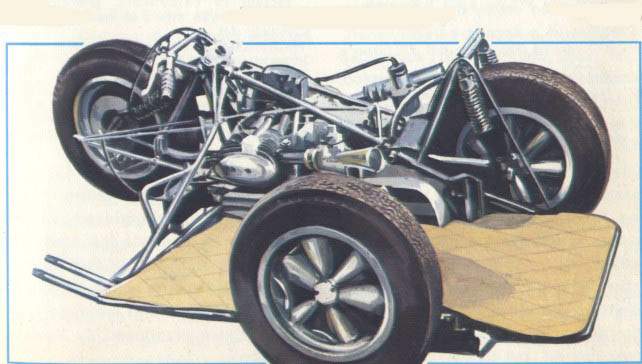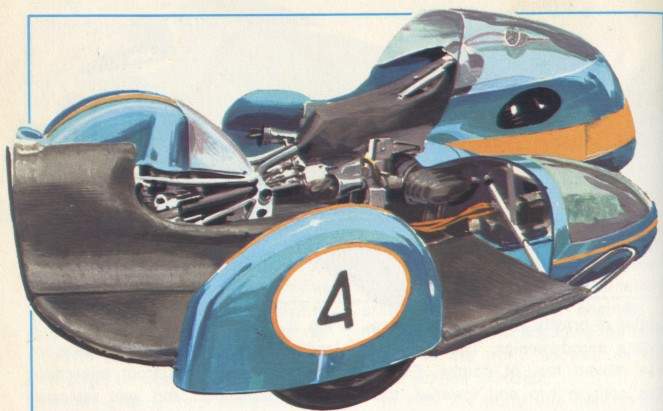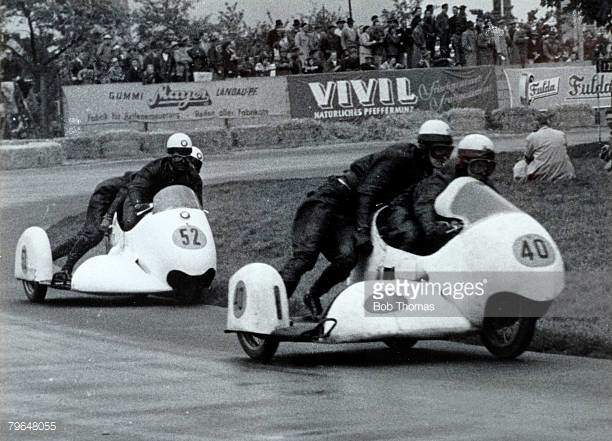
|
|
|
|
|
|
Classic Bikes
Custom Bikes
Individual
Racing Bikes AJP
AJS
Aprilia
Ariel
Avinton / Wakan
Bajaj
Benelli
Beta
Bimota
BMW
Brough Superior
BRP Cam-Am
BSA
Buell / EBR
Bultaco
Cagiva
Campagna
CCM
CF Moto
Combat Motors
Derbi
Deus
Ducati
Excelsior
GASGAS
Ghezzi Brian
Gilera
GIMA
Harley Davidson
Hero
Highland
Honda
Horex
Husaberg
Husqvarna
Hyosung
Indian
Jawa
Kawasaki
KTM
KYMCO
Laverda
Lazareth
Magni
Maico
Mash
Matchless
Mondial
Moto Guzzi
Moto Morini
MV Agusta
MZ / MuZ
NCR
Norton
NSU
Paton
Peugeot
Piaggio
Revival Cycles
Roland Sands
Royal Enfield
Sachs
Sherco
Sunbeam
Suzuki
SWM
SYM
Triumph
TVS
Ural
Velocette
Vespa
Victory
Vincent
VOR
Voxan
Vyrus
Walt Siegl
Walz
Wrenchmonkees
Wunderlich
XTR / Radical
Yamaha
Zero
Video
Technical
Complete Manufacturer List
|
BMW 500 Sidecar Racer |
| . |
For a long time the aim of every sidecar racer was to have a BMW engine, preferably one that was more powerful than his adversary's, of course, but in any case a bona fide BMW engine. It was not until many years later, when much more advanced four-cylinder engines began to appear (engines derived from those that had powered large-displacement vehicles without sidecars to world championship wins), that someone finally decided to see if a sidecar championship could be won without the classic BMW two-cylinder opposed-piston engine.
Until 1954 the world of sidecar racing had been dominated by
the British rider Eric Oliver, who drove a three-wheeler that was powered by a
Norton single-cylinder engine. When Wilhelm Noll entered the field with his BMW
sidecar, the situation was radically altered. Noll won the 1954 world
championship and showed that his German motorcycle would be the one to beat for
years to come.
Noll's sidecar was still a fairly rudimentary one.
The vehicle's winning capacity came strictly from its engine power. The wheels were high, and the fairing surely had not been studied in a wind tunnel. In 1955 Faust unexpectedly won the world championship. Naturally his sidecar was powered by a BMW engine. Early that year Noll had set seventy-eight sidecar records with two BMW motorcycles of the Rennsport type, with mixed air and direct injection feed.
Noll won the world championship again in 1956, and the
following year it was Fritz Hilldebrand who drove a BMW sidecar to the world
championship.
At this time there was no single-cylinder British vehicle that was capable of
matching the powerful German sidecar. Since the BMW company produced such
superior engines, it had no difficulty in engaging the best racers in the world
as well as the finest sidecar acrobats.
In 1958 the world title went to another great German racer, Walter Schneider,
who drove with Hans Strauss. Schneider won two consecutive world titles and then
decided to retire from racing competition.

Up to this time the engine that powered the strongest BMW sidecars had not been radically modified. The two-cylinder Rennsport engine was practically the same as the one Zeller and Geoffrey Duke had used in winning the 500 championship for two-wheeled motorcycles. The only innovations that were possible concerned the body of the vehicle and its aerodynamics. Improvements in this area could result in better performance. In 1958 there was a change in the steering style of official BMW sidecars. The traditional system had placed both the driver and the fuel tank on the upper bar of the chassis. Subsequently the driver was braced on his knees and wrists in order to lower the center of gravity and improve the vehicle's aerodynamics. The fuel tank was moved too, of course. First it was split in two and lowered, then later it was joined again and installed in the sidecar.
The change in riding position on the three-wheeler had been introduced by the great British racer Oliver in 1954, with his Norton. The BMW company was late in introducing it. This change also effected a radical alteration in the shape of three-wheelers. The front telescopic fork disappeared and was replaced by the type of suspension used in automobiles. The wheels were lowered until they were similar to the low-pressure tires of racing cars. In total, the resemblance to a motorcycle with a sidecar attached all but disappeared. But the track averages and top speeds in sidecar racing reached heights that had never before been anticipated for the class. It became clear that BMW sidecars, even without the help of special tuning, could beat any world records that had been set by the special two-wheelers of a decade earlier.
In 1960 Helmut Fath succeeded Walter Schneider as world champion. Then Max Deubel won the championship four years in a row. Deubel and his partner Emil Horner ceded the title the same year in which the BMW company withdrew from official racing. From that point on it was private racers who drove the BMW sidecars, which they tuned themselves. In 1968 when Fath again won the world championship, he did it with a four-cylinder engine in a sidecar that he had built himself, but this was an exceptional event in sidecar racing.
The motorcycles produced by BMW continued to dominate the scene for several years. The BMW three-wheeler was beaten only when its skilled drivers had to yield to the more powerful engines introduced by Yamaha and Konig.

Motorcycle: BMW 500 Sidecar Manufacturer: The vehicle
illustrated is
hand-constructed. Type: Racing Year: 1972
Engine: BMW Rennsport, two-cylinder, opposed-piston, 180°. Four-stroke. Double
single-shaft overhead distribution with bevel gear shaft. Direct injection or
carburetors. Displacement 4S3.9 cc. (68 mm. x 68 mm.)
Cooling: Air
Transmission: Four-speed block Power: Over 60 h.p. Maximum speed: About 135
m.p.h. Chassis: Open, tubular elements, with
stamped-plate and fiberglass parts.
Front and rear, hydraulic suspension Brakes: Front wheel, hydraulic double
disk; rear, hydraulic disk

|
Any corrections or more information on these motorcycles will be kindly appreciated. |